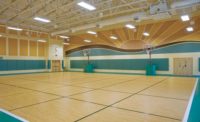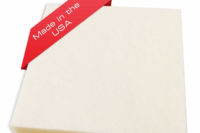When it comes to blending acoustical control with creative design, the writing’s on the wall—or the ceiling.
At least that’s the case at a St. Louis private school that recently installed leaf-shaped acoustical panels to play along with the school’s focus on math and science. Mary Institute and St. Louis Country Day School wanted a design that would both complement the school’s new STEM (science, technology, engineering and mathematics) building and provide superior sound absorption—while adding a little bit of style. The auburn and sage green leaf-shaped panels add a feeling of warmth to the school’s study commons and hearth room, and help to take down the noise when students get a little too excited about math and science.
The project showcases just one of many innovative uses of acoustical panel systems. In the last decade, architects and interior designers have expanded the traditional applications of acoustical systems – it’s out with blank, bulky panels and in with imaginative shapes, colors and fabrics that make a statement. G&S Acoustics has created several proprietary techniques to help its clients transform their acoustic panels into creative solutions that sometimes bring a smile.
Reclaiming valuable real estate
Designers understand the importance of maximizing the use of every square inch of a space. In the past, fabric-covered panels consumed valuable wall space and created an unwanted focal point. But thanks to custom acoustical panel technology, that valuable “real estate” can be used to control a space’s acoustical needs while contributing—and even blending into—the design. Designers featured in this article have boldly transformed acoustical systems inside gymnasiums, theaters, lobbies, churches and schools into jaw-dropping statement pieces.
Also featured are projects that have used acoustical panels as wayfinding cues and branding statements. Panels marked with corporate logos, message boards, signage, or directions can be as informative as they are striking. Businesses have found that printing promotional images onto acoustical panels double up as marketing tools.
This article also explores the possibilities available when acoustical panels, baffles and clouds are reconfigured into playful and at times unexpected shapes and sizes. Digital imaging can also transform ordinary blank panels into works of art, elevating a dull screen to a frame-worthy masterpiece.
A Clear Picture: Digital Imaging and Acoustic Fabrics
The process of creating custom printed acoustical panels revolves around dye sublimation printing, or digital printing directly on a fabric. Designers can select high quality digital artwork or high-resolution stock images from select websites, such as istockphoto.com or gettyimages.com or they can use their own photography or vector graphics. The images then can be applied to individual acoustic panels or a series of panels to create large mural images. The finished product can be wall or ceiling mounted, or hung as baffles or clouds.
To create a sharp and brilliant picture, images should be no less than 150 dpi (dots per inch). Preferred software formats are: Adobe Illustrator, Adobe Photoshop and Adobe InDesign as well as high resolution PDF files. Vector artwork files work best. Designers should plan extra “wrap” space that is one-and-a-half times the panel thickness on all sides. This will allow adequate fabric to cover the printed sides, which will result in a clean, smooth look.
Custom Cut Shapes Transform Spaces
Designers may be surprised to learn that acoustic control is defined by the square footage of acoustic material required to control the noise in a space. The location of the acoustical panels or baffles may not necessarily affect sound performance, which opens up more options when selecting the size and shape of acoustic elements in a space. Custom cut acoustic panels are becoming increasingly popular as a way to add drama, brand identity or a sense of purpose to a room. G&S’s Custom Shaped Panels can be wall mounted, ceiling mounted, hung as baffles and even as clouds. Most standard acoustical cores and sizes can be custom cut.
Getting Creative on a Budget
Schools have been the leading “early adopters” of using creative applications of acoustic materials. In the multi-purpose room at A.D. Stowell Elementary School in Hannibal, Mo., clouds, stars and moon custom shaped panels hang from the ceiling for sound control, but also add a kid-friendly architectural element.
Architect Martin Meyer of Architechnics Inc. in Quincy, Ill., notes that when designing for schools in rural areas, budgets are limited. But with careful layout of the stars and moon shapes, Meyer was able keep the required acoustic material to a minimum, obtain the acoustic control needed, and provide the elementary school kids with an element of surprise when they gaze up at the sky motif.
At Campus High School in Wichita, Kan., custom shaped panels were used for sound control in the school’s theatre in a curvature shape to create an architectural contrast to the black walls and chairs.
Custom Panels Pump up the School Spirit
In Jackson, Mo., the construction of a new 9,700 square foot transitional space was built to connect two existing buildings at Jackson High School. The space encompasses the school’s multipurpose common area and cafeteria—two areas where student traffic can ramp up the noise.
To address the volume control in the new space, the interior designers at Warner Nease Bost Architects in Kansas City decided to use custom shaped panels and digitally imaged acoustic treatments. Acousti-Image panels were used to create huge baffles printed with a yearbook-style collage of student photos. On the walls, Custom Shaped Panels were mounted in the school’s red and black colors in the shape of a large letter ‘J’ to fill the space with pride for Jackson.
The design team calculated the amount of square footage needed to keep the noise volume at a minimum, and the architects were free to design the space with custom shapes, as long as the math worked out to supply the required coverage. Jackson High School Principal, Vince Powell, was pleased with the results and so were the students. “The kids love it,” he says. “When you walk in the doors, you know you are at Jackson High. It personalized our new spaces in a way we never imagined.”
Custom Shaped Panels were mounted in the school’s red and black colors in the shape of a large letter J. The school also utilized Acousti-Images where a multitude of large Acousti-Image Baffles were hung from the ceiling using a collage of student photos, bringing life to the room.
Inspiration Comes from Above
The designers for the University Of British Columbia Facility of Pharmaceutical Sciences wanted to draw students’ attention upward to the ceiling with a dramatic design.
Saucier + Perrotte Architects and Hughes Condon Marler Architects worked together to design curved ceilings in the lecture halls, ensuring they were acoustically sound and student friendly. Working with B C Ceilings in Western Canada, the team created a grid pattern that would accommodate flat acoustic panels into the curvature of the bulkhead ceiling. Custom cut acoustic panels with micro-beveled edges were covered with nature-based custom colors to align with the overall color scheme of the school. On the walls, the architects specified a custom cut parallelogram pattern that subtly draws the eye to the front of the lecture hall.
Nature’s Way
Recreational destinations have found effective uses for custom panels, as noise levels tend to rise during busy times at popular tourist destinations. The architects designing the busy Lakeside Café inside The Saint Louis Zoo found a creative way to control the volume while incorporating themes of wildlife and nature.
Likewise, the Missouri Botanical Garden printed large images of botanical life onto panels that hang from the ceiling. The acoustical baffles-disguised-as-flower banners add beauty and mute the noise in a space that is often used for busy cocktail parties and events.
Digital printing technology and custom cut panels have successfully challenged the long held belief that acoustical panels are simply utilitarian elements of a building project. By blending an essential architectural element with a strong aesthetic, designers are working with a more colorful and creative palette than ever before.

















